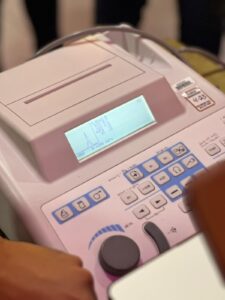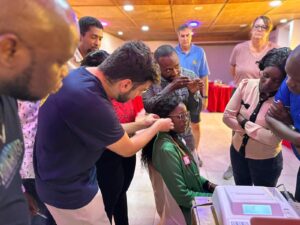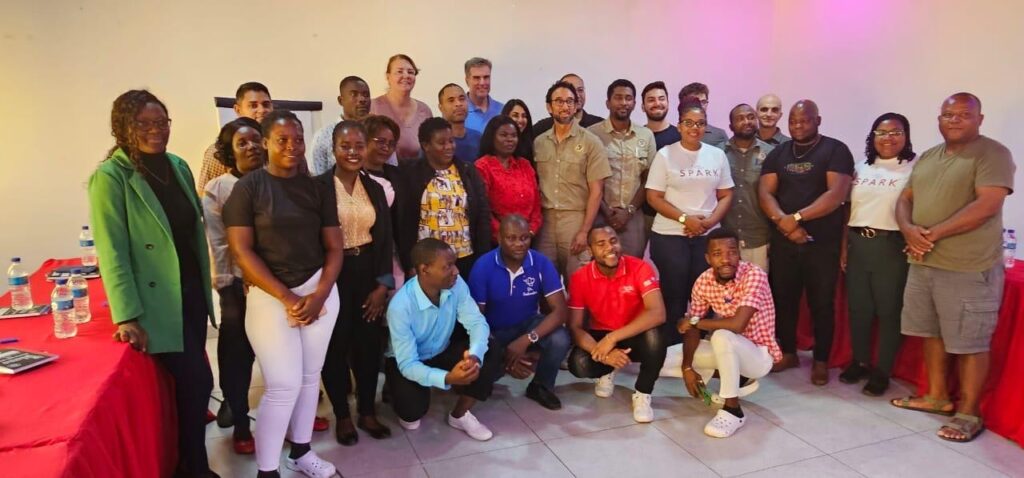Otitis media – a middle ear infection – is the number one cause of deafness in children around the world. Sub-Saharan Africa has one of the highest incidence rates, with over 40% of children affected. The Department of Otolaryngology-Head and Neck Surgery has partnered with healthcare leaders in the Gorongosa region of Mozambique to bring attention to otitis media and how to treat it.
A small delegation from the Department and the Eye & Ear Foundation recently traveled there, hosted by the Carr Foundation, led by American philanthropist Greg Carr. He was recently on 60 Minutes earlier this summer highlighting his work to restore the incredible biodiversity of Gorongosa National Park, and more importantly, supporting the communities around the park as they recover from decades of civil war.
The contingent from Pittsburgh included Department Chair Dr. José P. Zevallos, Dr. Peter Santa Maria, Dr. Chloe Santa Maria, Dr. Noel Jabbour, Eye & Ear Foundation CEO Lawton Snyder, and otolaryngology residents Dr. Nanki Hura and Dr. Khalil Baddour. They visited clinics and talked to health care workers throughout the region to understand the unmet medical needs of the community and how the Department may be able to collaborate to address these.
These clinics are suffering and had “the most appalling conditions,” according to Snyder. With not much electricity and no running water, checking for fluid in the ears is not a high priority. However, this leads to many children being undiagnosed and untreated with dire learning and developmental consequences. The team was challenged on how to provide hearing care when there is a lack of resources.

Hearing Diagnostics, LLC, donated a tympanometer – which measures the ear’s response to changes in air pressure and helps alert to signs of otitis media – on behalf of the Brother’s Brother Foundation to a clinic in Gorongosa National Park. Snyder’s wife, Susan Snyder, an audiologist and clinical assistant professor at Duquesne University, who accompanied him on the trip, taught the two otolaryngology residents, Drs. Hura and Baddour, how to use the device. They in turn taught the clinicians in Gorongosa. This was the first step in teaching health care workers how to identify the problem of otitis media with effusion.

Dr. Peter Santa Maria also donated two EarFlo devices to the clinic. EarFlo, designed and co-invented by Dr. Santa Maria and Australian engineers Matthew Oldakowski and Intan Oldakowska, is a clever Eustachian tube opening device disguised as a sippy cup. It is a non-invasive way to prevent and/or treat otitis media and reduce the need for surgery. This is essential in a region without access to ENT surgeons. One benefit of both these devices is that they can be cleaned and reused. The hope is to do a pilot study and retrieve data about their effectiveness in a very low resource setting.
While on the trip, Dr. Chloe Santa Maria, a laryngologist specializing in airway and care for the professional voice user, undertook work to focus on the importance of voice in the community. The diversity of the rural communities in Mozambique ranged from spiritual healers to girls’ clubs singing on social issues to religious groups. A program, “Voices of Gorongosa,” is making an impact by giving women a voice through singing.
“[The trip was] a life changing experience,” Snyder said. “I never expected to see the conditions I saw. You hear about it, but being there is another thing altogether.”
The goal is to make the hearing and otitis media project part of a larger mission to improve healthcare in the region, with the help of the Carr Foundation, Gorongosa, and hopefully partnership with Pitt. Additionally, with Mohit Singhala, PhD, joining Pittsburgh CREATES as lead engineer, there will be a renewed focus on helping solve problems like this in developing countries.
“Like EarFlo, we hope that through this collaboration, we can develop innovations in otolaryngology and beyond that will improve the lives of people in low resource settings like Mozambique,” Dr. Zevallos said.
